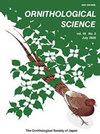The Behaviour of Japanese Night Heron Gorsachius goisagi on Awaji Island, Japan, Recorded by Camera Traps
IF 0.3
4区 生物学
Q4 ORNITHOLOGY
引用次数: 0
Abstract
Abstract Japanese Night Heron Gorsachius goisagi has recently been down-listed in status from Endangered to Vulnerable by BirdLife International due to the presence of a likely larger population than previously considered. However, there is still relatively little known about the ecology and current population status of this rare, elusive, and solitary species. In this study, we used infrared cameras to study its behaviour. We installed cameras at 120 locations on the forest floor of Awaji Island, Hyogo Prefecture, Japan, over approximately one year. Japanese Night Heron was recorded at 15 locations (132 video files of 25 independent events). All records except one were obtained during the daytime, and all involved herons walking on the forest floor where they were searching for potential prey items (most likely earthworms). Both adult and recently fledged juvenile herons were recorded, providing direct evidence that the species breeds on Awaji Island. Additionally, a zero-inflated Poisson GLMM analysis showed that Japanese Night Heron may not prefer evergreen coniferous plantations. Our results not only indicate that the species forages diurnally, contrary to its common name, but also sheds light on the importance of maintaining forests and foraging ground environments for the conservation of this species.日本淡水岛上日本夜鹭gosachius goisagi的行为,由相机陷阱记录
日本夜鹭(Gorsachius goisagi)最近被国际鸟盟(BirdLife International)从濒危物种降至易危物种,因为其数量可能比之前认为的要多。然而,对这种罕见的、难以捉摸的、独居的物种的生态和种群现状仍然知之甚少。在这项研究中,我们使用红外摄像机来研究它的行为。在大约一年的时间里,我们在日本兵库县Awaji岛的森林地面上安装了120个摄像机。《日本夜鹭》在15个地点(25个独立事件的132个视频文件)拍摄。除了一条记录外,所有记录都是在白天获得的,所有记录都涉及到苍鹭在森林地面上行走,寻找潜在的猎物(最有可能是蚯蚓)。记录了成年苍鹭和新近羽翼丰满的幼年苍鹭,为该物种在Awaji岛上繁殖提供了直接证据。此外,零膨胀泊松GLMM分析表明,日本夜鹭可能不喜欢常绿针叶林。我们的研究结果不仅表明该物种每天觅食,与它的常见名称相反,而且还揭示了维护森林和觅食地面环境对该物种保护的重要性。
本文章由计算机程序翻译,如有差异,请以英文原文为准。
求助全文
约1分钟内获得全文
求助全文
来源期刊

Ornithological Science
ORNITHOLOGY-
CiteScore
1.20
自引率
0.00%
发文量
26
审稿时长
>12 weeks
期刊介绍:
Ornithological Science publishes reviews, original articles, short communications and comments covering all aspects of ornithology. Manuscripts are judged on the basis of their contribution of original data and ideas or interpretation. All articles are peer-reviewed by at least two researchers expert in the field of the submitted paper. Manuscript are edited where necessary for clarify and economy. Ornithological Science aims to publish as rapidly as is consistent with the requirements of peer-review and normal publishing constraints.
 求助内容:
求助内容: 应助结果提醒方式:
应助结果提醒方式:


